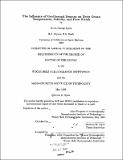The influence of geothermal sources on deep ocean temperature, salinity, and flow fields
Author(s)
Speer, Kevin G. (Kevin George)
DownloadFull printable version (8.713Mb)
Other Contributors
Woods Hole Oceanographic Institution.
Advisor
Terrence M. Joyce.
Terms of use
Metadata
Show full item recordAbstract
This thesis is a study of the effect of geothermal sources on the deep circulation, temperature and salinity fields. In Chapter 1 background material is given on the strength and distribution of geothermal heating. In Chapter 2 evidence for the influence of a hydrothermal system in the rift valley of the Mid-Atlantic Ridge on nearby property fields and a model of the flow around such a heat source are presented, with an analysis of a larger-scale effect. Results of an analytical model for a heat source on a #-plane in Chapter 3 show how the response far from the source can have a structure different from the forcing because of its dependence on two parameters: a Peclet number (the ratio of horizontal advection and vertical diffusion), and a Froude-number-like parameter (the ratio of long wave phase speed to background flow speed) which control the relative amount of damping and advection of different vertical scales. The solutions emphasize the different behavior of a dynamical field like temperature compared to tracers introduced at the source. These ideas are useful for interpreting more complicated solutions from a numerical model presented in the final chapter.
Description
Thesis (Ph. D.)--Joint Program in Oceanography (Massachusetts Institute of Technology, Dept. of Earth, Atmospheric, and Planetary Sciences; and the Woods Hole Oceanographic Institution), 1988. Includes bibliographical references (p. 142-146).
Date issued
1988Department
Joint Program in Oceanography; Woods Hole Oceanographic Institution; Massachusetts Institute of Technology. Department of Earth, Atmospheric, and Planetary SciencesPublisher
Massachusetts Institute of Technology
Keywords
Joint Program in Oceanography., Earth, Atmospheric, and Planetary Sciences., Woods Hole Oceanographic Institution.